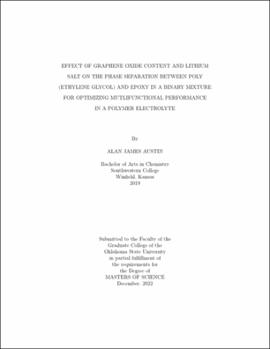| dc.contributor.advisor | Singh, Raman P. | |
| dc.contributor.author | Austin, Alan James | |
| dc.date.accessioned | 2023-08-02T19:47:23Z | |
| dc.date.available | 2023-08-02T19:47:23Z | |
| dc.date.issued | 2022-12 | |
| dc.identifier.uri | https://hdl.handle.net/11244/338817 | |
| dc.description.abstract | Structural supercapacitors represent a promising technology that will help in mitigating range anxiety while providing structural integrity to electric vehicles. Poly (ethylene glycol) (PEG), the ionic component of structural supercapacitor, is responsible for providing percolating channels for ion transfer. The formation of a percolating network of PEG inside epoxy resin is the result of cure-reaction induced phase separation (CRIPS) that occurs at curing temperature due to spinodal decomposition. Various nanofillers have been explored (organoclay, TiO₂ nanoparticles, and LLZO) that enhance the ionic conductivity while improving the mechanical properties. Graphene oxide is a promising nanofiller that has the ability to improve the ionic conductivity due to the presence of it’s oxygen-rich functional groups on its basal plane, and also provides excellent mechanical properties. It is imperative to understand the effect of graphene oxide on the formation of percolating channels, since the percolating ionic channels will directly impact the ionic conductivity of the structural supercapacitor. This study explores the effect of change in weight percentage of graphene oxide and how it affects phase separation. Graphene oxide content is varied from (0 to 0.7 weight percentage with respect to PEG) to study how phase separation between PEG and epoxy is affected. Scanning electron microscopy (SEM) images show promising results suggesting a decrease in pore diameter as amount of graphene oxide is increased, that will enhance the mechanical and electrical properties. By varying the amounts of graphene oxide, we are able to achieve an electrolyte that provides optimal multi-functional performance. Detailed study on the effect of graphene oxide in percolating PEG network in tailoring of mechanical and ionic conductivity properties will be presented and discussed. | |
| dc.format | application/pdf | |
| dc.language | en_US | |
| dc.rights | Copyright is held by the author who has granted the Oklahoma State University Library the non-exclusive right to share this material in its institutional repository. Contact Digital Library Services at lib-dls@okstate.edu or 405-744-9161 for the permission policy on the use, reproduction or distribution of this material. | |
| dc.title | Effect of graphene oxide content and lithium salt on the phase separation between poly (ethylene glycol) and epoxy in a binary mixture for optimizing multifunctional performance in a polymer electrolyte | |
| dc.contributor.committeeMember | Azoug, Aurelie | |
| dc.contributor.committeeMember | Bair, Jake | |
| dc.contributor.committeeMember | Vaidyanathan, Ranji | |
| osu.filename | Austin_okstate_0664M_17878.pdf | |
| osu.accesstype | Open Access | |
| dc.type.genre | Thesis | |
| dc.type.material | Text | |
| thesis.degree.discipline | Materials Science and Engineering | |
| thesis.degree.grantor | Oklahoma State University | |
